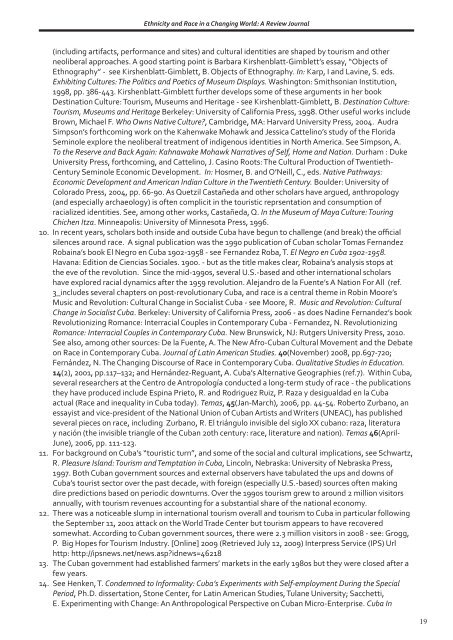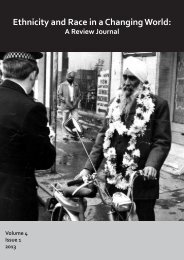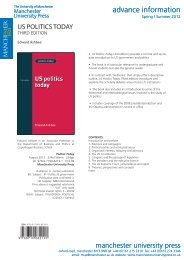Ethnicity and Race in a Changing World
Volume 2, Issue 1, 2011 - Manchester University Press
Volume 2, Issue 1, 2011 - Manchester University Press
Create successful ePaper yourself
Turn your PDF publications into a flip-book with our unique Google optimized e-Paper software.
<strong>Ethnicity</strong> <strong>and</strong> <strong>Race</strong> <strong>in</strong> a Chang<strong>in</strong>g <strong>World</strong>: A Review Journal(<strong>in</strong>clud<strong>in</strong>g artifacts, performance <strong>and</strong> sites) <strong>and</strong> cultural identities are shaped by tourism <strong>and</strong> otherneoliberal approaches. A good start<strong>in</strong>g po<strong>in</strong>t is Barbara Kirshenblatt-Gimblett’s essay, “Objects ofEthnography” - see Kirshenblatt-Gimblett, B. Objects of Ethnography. In: Karp, I <strong>and</strong> Lav<strong>in</strong>e, S. eds.Exhibit<strong>in</strong>g Cultures: The Politics <strong>and</strong> Poetics of Museum Displays. Wash<strong>in</strong>gton: Smithsonian Institution,1998, pp. 386-443. Kirshenblatt-Gimblett further develops some of these arguments <strong>in</strong> her bookDest<strong>in</strong>ation Culture: Tourism, Museums <strong>and</strong> Heritage - see Kirshenblatt-Gimblett, B. Dest<strong>in</strong>ation Culture:Tourism, Museums <strong>and</strong> Heritage Berkeley: University of California Press, 1998. Other useful works <strong>in</strong>cludeBrown, Michael F. Who Owns Native Culture?, Cambridge, MA: Harvard University Press, 2004. AudraSimpson’s forthcom<strong>in</strong>g work on the Kahenwake Mohawk <strong>and</strong> Jessica Cattel<strong>in</strong>o’s study of the FloridaSem<strong>in</strong>ole explore the neoliberal treatment of <strong>in</strong>digenous identities <strong>in</strong> North America. See Simpson, A.To the Reserve <strong>and</strong> Back Aga<strong>in</strong>: Kahnawake Mohawk Narratives of Self, Home <strong>and</strong> Nation. Durham : DukeUniversity Press, forthcom<strong>in</strong>g, <strong>and</strong> Cattel<strong>in</strong>o, J. Cas<strong>in</strong>o Roots: The Cultural Production of Twentieth-Century Sem<strong>in</strong>ole Economic Development. In: Hosmer, B. <strong>and</strong> O’Neill, C., eds. Native Pathways:Economic Development <strong>and</strong> American Indian Culture <strong>in</strong> the Twentieth Century. Boulder: University ofColorado Press, 2004, pp. 66-90. As Quetzil Castañeda <strong>and</strong> other scholars have argued, anthropology(<strong>and</strong> especially archaeology) is often complicit <strong>in</strong> the touristic reprsentation <strong>and</strong> consumption ofracialized identities. See, among other works, Castañeda, Q. In the Museum of Maya Culture: Tour<strong>in</strong>gChichen Itza. M<strong>in</strong>neapolis: University of M<strong>in</strong>nesota Press, 1996.10. In recent years, scholars both <strong>in</strong>side <strong>and</strong> outside Cuba have begun to challenge (<strong>and</strong> break) the officialsilences around race. A signal publication was the 1990 publication of Cuban scholar Tomas Fern<strong>and</strong>ezRoba<strong>in</strong>a’s book El Negro en Cuba 1902-1958 - see Fern<strong>and</strong>ez Roba, T. El Negro en Cuba 1902-1958.Havana: Edition de Ciencias Sociales. 1900. - but as the title makes clear, Roba<strong>in</strong>a’s analysis stops atthe eve of the revolution. S<strong>in</strong>ce the mid-1990s, several U.S.-based <strong>and</strong> other <strong>in</strong>ternational scholarshave explored racial dynamics after the 1959 revolution. Alej<strong>and</strong>ro de la Fuente’s A Nation For All (ref.3_<strong>in</strong>cludes several chapters on post-revolutionary Cuba, <strong>and</strong> race is a central theme <strong>in</strong> Rob<strong>in</strong> Moore’sMusic <strong>and</strong> Revolution: Cultural Change <strong>in</strong> Socialist Cuba - see Moore, R. Music <strong>and</strong> Revolution: CulturalChange <strong>in</strong> Socialist Cuba. Berkeley: University of California Press, 2006 - as does Nad<strong>in</strong>e Fern<strong>and</strong>ez’s bookRevolutioniz<strong>in</strong>g Romance: Interracial Couples <strong>in</strong> Contemporary Cuba - Fern<strong>and</strong>ez, N. Revolutioniz<strong>in</strong>gRomance: Interracial Couples <strong>in</strong> Contemporary Cuba. New Brunswick, NJ: Rutgers University Press, 2010.See also, among other sources: De la Fuente, A. The New Afro-Cuban Cultural Movement <strong>and</strong> the Debateon <strong>Race</strong> <strong>in</strong> Contemporary Cuba. Journal of Lat<strong>in</strong> American Studies. 40(November) 2008, pp.697-720;Fernández, N. The Chang<strong>in</strong>g Discourse of <strong>Race</strong> <strong>in</strong> Contemporary Cuba. Qualitative Studies <strong>in</strong> Education.14(2), 2001, pp.117–132; <strong>and</strong> Hernández-Reguant, A. Cuba’s Alternative Geographies (ref.7). With<strong>in</strong> Cuba,several researchers at the Centro de Antropología conducted a long-term study of race - the publicationsthey have produced <strong>in</strong>clude Esp<strong>in</strong>a Prieto, R. <strong>and</strong> Rodriguez Ruiz, P. Raza y desigualdad en la Cubaactual (<strong>Race</strong> <strong>and</strong> <strong>in</strong>equality <strong>in</strong> Cuba today). Temas, 45(Jan-March), 2006, pp. 44-54. Roberto Zurbano, anessayist <strong>and</strong> vice-president of the National Union of Cuban Artists <strong>and</strong> Writers (UNEAC), has publishedseveral pieces on race, <strong>in</strong>clud<strong>in</strong>g Zurbano, R. El triángulo <strong>in</strong>visible del siglo XX cubano: raza, literaturay nación (the <strong>in</strong>visible triangle of the Cuban 20th century: race, literature <strong>and</strong> nation). Temas 46(April-June), 2006, pp. 111-123.11. For background on Cuba’s “touristic turn”, <strong>and</strong> some of the social <strong>and</strong> cultural implications, see Schwartz,R. Pleasure Isl<strong>and</strong>: Tourism <strong>and</strong> Temptation <strong>in</strong> Cuba, L<strong>in</strong>coln, Nebraska: University of Nebraska Press,1997. Both Cuban government sources <strong>and</strong> external observers have tabulated the ups <strong>and</strong> downs ofCuba’s tourist sector over the past decade, with foreign (especially U.S.-based) sources often mak<strong>in</strong>gdire predictions based on periodic downturns. Over the 1990s tourism grew to around 2 million visitorsannually, with tourism revenues account<strong>in</strong>g for a substantial share of the national economy.12. There was a noticeable slump <strong>in</strong> <strong>in</strong>ternational tourism overall <strong>and</strong> tourism to Cuba <strong>in</strong> particular follow<strong>in</strong>gthe September 11, 2001 attack on the <strong>World</strong> Trade Center but tourism appears to have recoveredsomewhat. Accord<strong>in</strong>g to Cuban government sources, there were 2.3 million visitors <strong>in</strong> 2008 - see: Grogg,P. Big Hopes for Tourism Industry. [Onl<strong>in</strong>e] 2009 (Retrieved July 12, 2009) Interpress Service (IPS) Urlhttp: http://ipsnews.net/news.asp?idnews=4621813. The Cuban government had established farmers’ markets <strong>in</strong> the early 1980s but they were closed after afew years.14. See Henken, T. Condemned to Informality: Cuba’s Experiments with Self-employment Dur<strong>in</strong>g the SpecialPeriod, Ph.D. dissertation, Stone Center, for Lat<strong>in</strong> American Studies, Tulane University; Sacchetti,E. Experiment<strong>in</strong>g with Change: An Anthropological Perspective on Cuban Micro-Enterprise. Cuba In19






